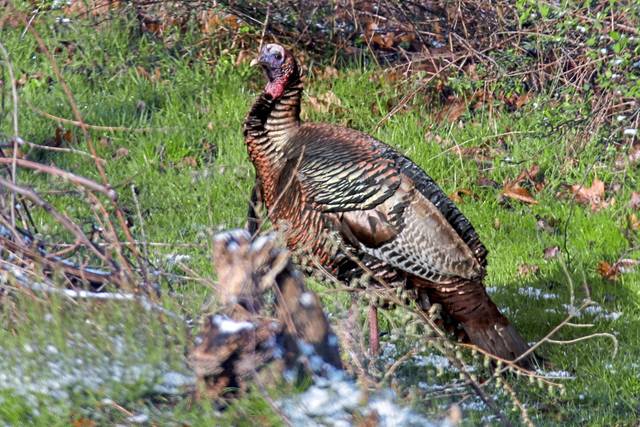https://triblive.com/sports/focus-on-natural-food-sources-for-success-hunting-fall-turkeys/
Focus on natural food sources for success hunting fall turkeys

When hunting turkeys, success is always predicated by the bird’s interest in one of two things: sex or food.
During spring gobbler season, concentrate on the desire of toms to mate, but when hunting turkeys in the fall, think food. Like most creatures out there, turkeys spend their fall days trying to find enough food to fatten up for the winter.
Mast crops often dictate fall success rates for turkeys, but interestingly enough too much of a mast crop can actually make finding the birds a more difficult proposition than in years when there’s a poor mast crop or a selectively poor mast crop. Such conditions might actually help to concentrate the birds, while having a plentiful mast crop means the birds can be feeding in a lot more places.
Unlike the spring when a gobbler may reveal its position by gobbling, in the fall birds are generally less noisy as a general rule, unless a flock is broken up and sounds off with assembly calls. The key to getting a bird in the fall is to first find a flock, which most likely will happen if they are heard.
More travel is required to find turkeys in the fall, but if living in good turkey habitat they can be located by simply driving back roads and searching likely food sources such as cut corn fields, edges of fields, berry patches and openings on side hills. In all likelihood the most effective means of scouting will be done on foot looking for droppings, fresh feathers and dusting areas.
Once a flock is found and scattered, one of the most effective calls to use in the fall is the “kee-kee” run, which is the lost whistle call of a jake, or yearling male turkey, and will elicit a response not only from other jakes, but also from hens. Try calling briefly, then moving 100 yards or so, then calling briefly again, and continue to do this and cover a wide area, hoping to eventually hear some birds.
While it is no longer a requirement to wear blaze orange when hunting turkeys in the fall, remember to hunt as safely as possible. While calling and moving to try and locate birds may be helpful to success, it may not be as safe as sitting against a tree that is marked with a strip of blaze orange and calling. And yes, turkeys see orange, but so do other hunters.
Using a hen yelp is also effective in the fall because when birds flock up, hens and jakes flock up together. There always is a boss hen in the group, so try yelping loudly, putting extra emotion and feel and power into each yelp.
If a hen hears it, she usually perceives it as a threat and will respond accordingly with some powerful yelps of her own, so mimic her, and whatever and however she calls, do it right back to her, as this will really antagonize her. More than likely she will come looking for a fight and bring the whole flock along, and if she does, then the fun can really begin.
When breaking up a flock, try to run in yelling, perhaps stopping to take a shot in the air and doing whatever to scatter the birds in different directions. If they all go in the same direction, they will regroup together somewhere else, but if they scatter, they will regroup where they broke up.
That is when the best tactic is to get set against a tree, wait maybe 15 minutes or so, and begin to call, using the hen yelp or “kee-kee” run. Hearing turkey call in the fall as they reassemble is a real treat as they want to flock up again, as they want to travel in flocks in the fall, and some of the birds actually come running in to calls.
Hunting gobblers in the fall can be even tougher than hunting them in the spring, as often a small group of gobblers will flock up in a bachelor group. If finding a group and breaking them up, sit back where they broke up and wait 30 minutes before making a single male yelp or two. Then remain quiet for another 20 minutes or so before repeating a series of calls.
Gobblers are wary, quiet, defensive and careful, doing little calling and will approach quietly. In many ways, this makes a gobbler taken in the fall more of a trophy than one taken in the spring.
Copyright ©2025— Trib Total Media, LLC (TribLIVE.com)
